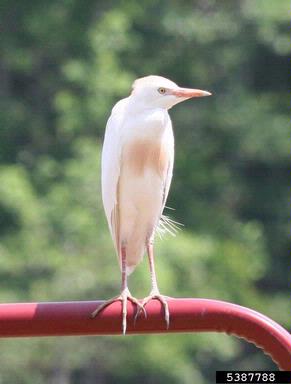Bubulcus ibis
Cattle Egret
Class: Aves
Order: Ciconiiformes
Family: Ardeidae

Photographer: Johnny N. Dell, Bugwood.org
Source: http://www.invasive.org/browse/detail.cfm?imgnum=5387788
Description
Bubulcus ibis is a small white heron about 20 inches long with a wingspan of 36 inches and when standing it is typically in a hunched position. Most of the year the plumage is white but during the mating season tan-orange feathers appear on the crown, throat and back. The bill is yellow and the legs are yellow to gray-green in non-breeding season, but both the bill and the legs turn red during breeding season.
Ecological Threat: Fortunately the Cattle Egret doesn’t have an impact on native heron species because it has a different diet and breeding season. The main threat of this bird species is on the islands of Hawaii where they feed on the eggs of endangered wetland birds and compete with insect eating species like frogs, toads and skinks. Furthermore, they are damaging aquaculture habitats by eating prawns and cause hazards at local airports. Their benign behavior on “the mainland” could always change and in the South the Cattle Egret could severely damage the large aquaculture industries there.
Biology: Cattle Egrets are gregarious and fly to and from feeding areas in flocks. Their diet consists of insects like flies that tend to reside upon livestock animals. They are also consumers of ticks and other parasites that are draining the livestock, due to this you can sometimes see Cattle Egrets standing on the animal’s back. Males will establish breeding territories from spring through early summer; courtship occurs and pair-bonds are established that last the season. Nest-building and mating lasts about 3 days the egg-laying begins. Clutches are about 34 eggs and both sexes incubate the eggs for about 24 days. 2 to 3 weeks after hatching, the hatchlings leave the nest and a week later they are flying. Juveniles disperse in random directions and after 2 to 3 years they become breeding members of the population.
History: Introduction into the Americas was a natural and migratory event. The cattle egrets crossed the Atlantic Ocean and were documented in Suriname, South America in the late 1870s. By 1917 it was in Columbia and in the 1940s it reached Florida. In the United States the long-distance habits let Bubulcus ibis spread quickly and by the 1960s it was establish in California and Canada. In 1959 the bird was intentionally introduced into Hawaii as a biological control for flies and other cattle pests, however, now the cattle egret is considered a major pest on the islands.
U.S. Habitat: Pastures, ploughed fields and marshes; thrive in altered habitats.
Distribution
Native Origin: Africa, Spain, Portugal, India and Southeast Asia
U.S. Present: All states; but breeding populations in AL, AR, CA, GA, KS, KY, MS, OK, NC, PR, SC, TN, TX and VA
Management
For Hawaii, they’ve tried population reduction and control efforts but seem to only provide temporary relief due to the high mobility of these birds. However, repelling techniques have proved to be somewhat successful at Hawaii’s airports.
References
Woodward, Susan L., and Joyce Ann. Quinn. "Cattle Egret." Encyclopedia of Invasive Species: From Africanized Honey Bees to Zebra Mussels. Santa Barbara, CA: Greenwood, 2011. 228-31. Print.
Internet References
http://www.aphis.usda.gov/wildlife_damage/nwrc/publications/07pubs/pitt071.pdf
http://www.issg.org/database/species/ecology.asp?si=970&fr=1&sts=sss&lang=EN
Back to Invasive Birds and Mammals
 Texas Invasive Species Institute
Texas Invasive Species Institute